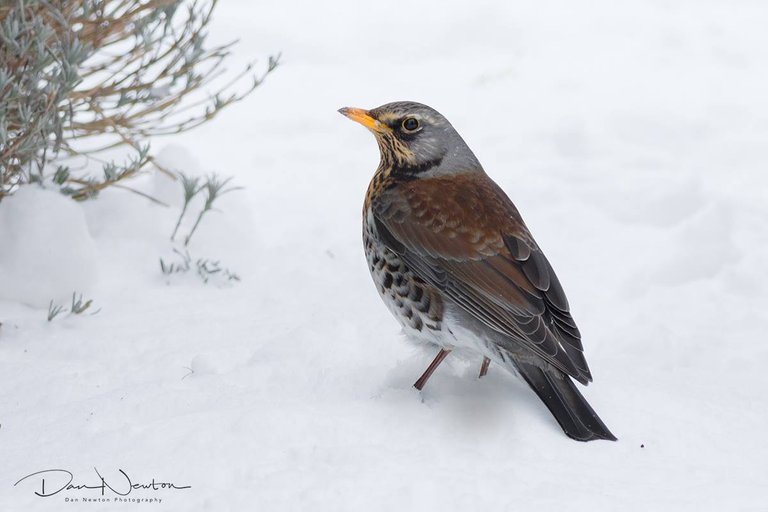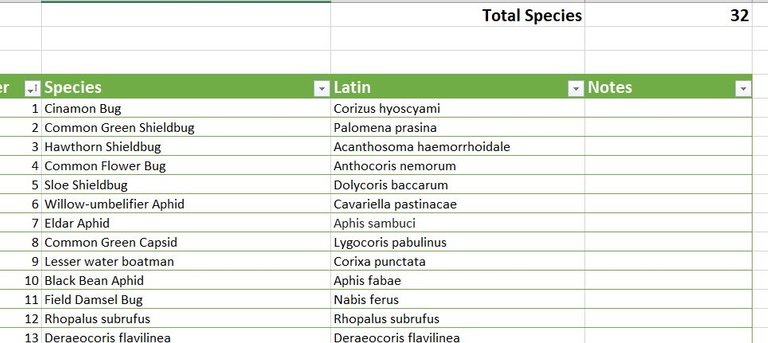I recently shared a post about a Garden Safari that I went on, at some point last week. I spoke about the joys of sitting in the sun watching the wildlife around me, but the exciting part was how I found a new species of Hoverfly that I had not seen in the garden before. It was really cool to see, and takes the Species Count of the Garden up to an amazing 849 species.
I have written about creating a List of Species in a previous post, but I thought it would be worth the effort to go through it properly and show just how much variety of invertebrates and birds and plants and all sorts of other animals there are to see in the garden.
A few points before we begin:
- I only include species to the list that I am sure of (or had verification from an expert)
- Not all 800 odd species are present in the garden at any one time (obviously) The vast majority are only present for a short amount of time, or even just briefly passing through the area.
- My work (project, hobby, whatever you want to call it) is inspired by a book written by Jennifer Owen Wildlife of a Garden: A Thirty Year Study. The book tells how she spent all her spare time in her garden documenting everything she could see.
Introduction done: lets get to it!
Birds (Aves or Avialae) - 31 Species
Compared to many group of invertebrates, Birds are a well known and much studied group of animals. The origin of birds as a group as been studied intensely and current research on taxonomic classification states that birds are technically the the last surviving group of theropod dinosaurs, although that may still change if/when new fossils are discovered. Be that as it may, they are a fascinating and varied group of animals.

Wren - Troglodytes troglodytes
This is one of the birds seen in the garden. The Wren is an insectivore (feeds on insects like flies, and caterpillars) which means it is never seen on bird feeders. Research suggests that it is the UKs commonest bird. However it is usually skulking amongst the undergrowth looking for food, so I very rarely see it. This photo was the first time a Wren has stopped moving long enough for me to take a picture!

Fieldfare - Turdus pilaris
From a common bird to a much rarer one, Fieldfares are a regular (but uncommon) sighting in the UK in Winter. Numbers fluctuate each year depending on the weather and wind direction, but they are usually found in small flocks near farmland eating berries. People in the UK will definitely remember the Beast From The East which occured back in 2018. This was when an unusually cold weather system swept in from Russia resulting in the whole country covered in snow at the end of March (extremely unusual weather).
That cold front forced a lot of birds to disperse to different locations to avoid the worst of the cold and that resulted in record numbers of Fieldfares and Redwings appearing across the UK and they ended up everywhere including peoples gardens. There were 4 of them in my garden during this period, and they stayed for about a week until the weather improved. It was purely down to the extraordinary weather we had at the time, so I doubt I will ever see a Fieldfare in the garden again!

Diamond Dove - Geopelia cuneata
One last bird here, and this is a sadder story. I spotted this out of the kitchen window, and immediately new it was something different. It looked like a Collared Dove in size but there is no native bird in the UK that looks like this. I immediately dashed to get a camera before it flew off.
That Red Eye was distinctive, I had no idea what it was, but it also looked strangely familiar. A quick spot of research revealed it to be a Diamond Dove. And then I remembered where I had seen it before, a local zoo has a tropical house, with a few exotic birds inside. I checked their website, and it showed pictures of the Diamond Dove. This was an escaped bird. Its natural habitat is the temperate area of Australia, which means it could probably survive here in the UK, but that would mean 2-3 years without seeing its own kind again. It was a really interesting record, but sad at the same time.
Bugs (Hemiptera) - 32 Species
Bugs are another interesting group. Like Beetles, they exist in lots of different shapes and colours and they are often quite hard to ID. My list has 32 species, but that is only the ones that stand out from the rest. A lot of the others can superficially look quite similar. I strongly suspect I have more than 32 species here, but I need to improve my own knowledge first. Lets look at some of the 'easier' ones:

Corizus hyoscyami
These are strikingly marked insects, and here in the UK they are pretty much the only red and black plant bug around. There is a similar species found right down on the South Coast, but even then they don't really look the same. This was one of the first bugs I saw in the garden, and inspired me to start making a list of all the insects in the garden. At that time I was only looking at butterflies and moths. Corizus hyoscyami is another Spring species, and one I look forward to seeing each year.

Oncotylus viridiflavus
Another distinctive bug, Oncotylus viridiflavus is easily Identified by the blueish-green ground colour and black patterning on the head and pronotum (the pronotum is the part of the insect between the head and where the wings attach). They are often found on the flowers of various Knapweeds

This is a Dock bug. it is relativity common across the southern half of the UK, and we have often seen it while out and about. It had never been recorded in the garden, until late last year when I spotted this one in the corner resting on a Dock leaf. A large and interesting bug to admire, and take photos of and another to add to our ever growing list
On that note I will finish this instalment. I don't want to over do it (or bore you to death!) so I will save the rest for another time
Hopefully you can see that this is a project that I am really interested in. As usual if you have any comments or questions then please write them below
Next week I will continue with the different species of Butterflies and Dragonflies I have seen in the garden...
All images by @dannewton
All names confirmed and checked via Wikispieces



Hi @dannewton,
Thank you for participating in the #teamuk curated tag. We have upvoted your quality content.
For more information visit our discord https://discord.gg/8CVx2Am
Yeah these all are found in garden and can be found in fields as well, thank you for the informative post
Thanks for reading, I'm pleased you found it interesting :-)
Yeah being a zoologist i love to know more and more
I like how you use colored paper! I will definitely steal it for some photos. 😂
Thank you! Its an acquired taste, and not everyone likes it... but I think it creates some interesting images
you are welcome to have a go yourself, top tip: don't use red paper, the colour is so bold and bright and overpowering that it distracts from the main subject.
Thanks for the tip. I'll play with different colors just to get the right contrast.